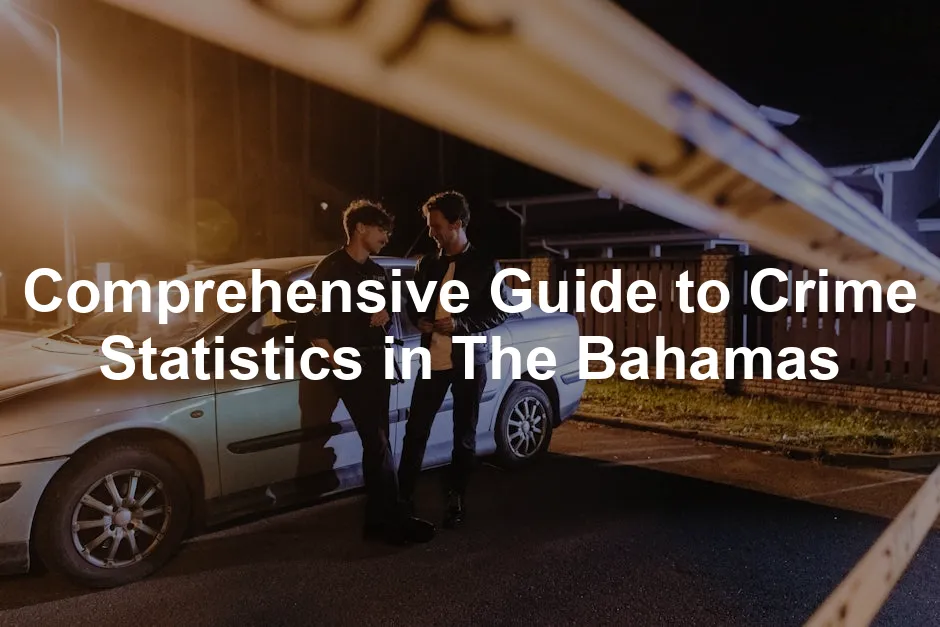Introduction
The Bahamas, known for its stunning beaches and vibrant culture, faces a complex crime landscape. While tourists flock to its shores, it’s essential to understand the underlying crime situation. Recent statistics reveal a mix of challenges and improvements, making it crucial for both residents and visitors to stay informed.
Understanding crime statistics helps gauge safety levels. For residents, it informs daily life choices. Tourists can plan safer travel routes and activities. Knowledge is power, right? The Royal Bahamas Police Force and various research organizations publish valuable data. This data encompasses violent crimes, property crimes, and more, providing a fuller picture of safety across the islands.
If you’re curious about the broader implications of crime and justice, consider diving into “The Complete Guide to Crime Scene Investigation” by Michael J. McCarthy. This book offers an in-depth look at the processes and techniques used to solve crimes, making it a fascinating read for anyone interested in criminal justice!
Numerous sources offer crime statistics. The Royal Bahamas Police regularly updates their reports. Other platforms, like Macrotrends and Worldmetrics, analyze historical data and trends. These insights are essential for grasping the changes over the years.
This article will cover several key sections. We will explore historical crime trends, current statistics, regional crime analysis, and factors affecting crime rates. By the end, readers will have a comprehensive understanding of crime statistics in The Bahamas, equipping them with the knowledge to navigate this beautiful yet complex paradise.

Historical Overview of Crime in The Bahamas
Crime Trends Over the Years
From 2000 to 2023, crime in The Bahamas has fluctuated remarkably. Early 2000s data showed a rising crime rate, particularly in urban areas like Nassau. This trend continued until about 2015, when the government began implementing stricter crime policies and community programs.
Significant events, such as natural disasters and political changes, have influenced these trends. For instance, Hurricane Dorian in 2019 forced many people into precarious situations, leading to a spike in crimes like theft and armed robbery. Graphs showing these trends reveal the peaks and valleys in crime rates over the years, illustrating the impact of various social factors.
For a deeper understanding of the psychological aspects behind criminal behavior, check out “The Mind of the Criminal: A Psychological Perspective” by John H. Blume. This insightful book delves into the motivations and mental states that lead to criminal behavior.
From 2016 onward, a notable decline in crime rates emerged, attributed to increased police presence and community engagement. However, the recent uptick in specific categories, like sexual assaults, raises concerns. Understanding these patterns is essential for both residents and tourists to navigate the islands safely.

Key Milestones
Key milestones in combating crime include various laws and policies. For instance, the introduction of the Firearms Act aimed to reduce illegal gun possession. Similarly, the establishment of community policing initiatives has fostered better relationships between law enforcement and the communities they serve.
Major crime incidents also shape public perception. The highly publicized murder cases often create a sense of fear and urgency among residents. As a result, discussions surrounding crime prevention become vital.
Speaking of crime prevention, if you want to explore the strategies employed to fight crime, consider reading “Criminal Justice: A Brief Introduction” by Frank Schmalleger. It provides a concise overview of the criminal justice system and its components.
In conclusion, the historical overview of crime in The Bahamas reveals a complex interplay of factors. By analyzing trends and key milestones, residents and tourists can better understand the evolving crime landscape. This knowledge is essential for fostering a safer environment for everyone involved.

Current Crime Statistics
Overview of Recent Crime Data
In the Bahamas, crime statistics reveal a mixed bag of trends for 2022 and 2023. Overall, there was a notable reduction in serious crime, with a reported drop of 21% in major offenses. In 2023, a total of 3,153 major crimes were recorded, down from 3,979 in 2022. This shows a commitment to enhancing safety across the islands, although challenges remain.
Breaking down these figures, violent crimes account for a significant portion of reported incidents. In 2023, there were 110 homicides, a decrease from 128 in 2022. This translated to a solvency rate of 65%, with 72 cases solved. However, the number of sexual assaults saw a slight uptick, with 134 reported in 2023 compared to 139 in 2022. It’s a sobering reminder that while some crimes are declining, others remain a pressing concern.
For those interested in understanding the broader implications of crime in society, consider “The Psychology of Crime and Criminal Justice” by Jennifer M. Brown. This book provides insights into the psychological aspects behind criminal behavior and justice.
When it comes to property crimes, a 19% decrease was noted, totaling 2,356 incidents in 2023, down from 2,907 in 2022. The drop in armed robberies was significant, with only 368 reported in 2023, down from 555 the previous year. Vehicle thefts also saw a decrease, with 257 incidents in 2023 compared to 330 in 2022.
Comparing these figures with previous years highlights the fluctuating nature of crime in the Bahamas. For instance, in 2021, the country reported 4,081 major crimes, which indicates a significant decrease more recently. This downward trend is a positive sign, yet the persistent issues of sexual violence and theft demand ongoing attention.
For a detailed exploration of crime statistics, consider reviewing this comprehensive analysis of safety in 2023. fremont crime statistics

Detailed Breakdown by Crime Type
Violent Crimes:
Homicides remain a critical area of focus. The 110 reported in 2023 reflect ongoing challenges, but the solvency rate of 65% is encouraging. Notable cases often draw media attention, which can influence public perception and fear. The increase in sexual assaults, while not drastically high, signals a need for societal intervention and awareness.
Property Crimes:
Property crimes are a mixed bag. The reduction in burglary rates and vehicle thefts is promising. In 2023, house break-ins dropped to 372 incidents from 507 in 2022. However, the concern over robberies persists, and the community must remain vigilant. With tourists often targeted, it’s crucial to foster a culture of safety and awareness.
If you’re looking to understand the sociology behind crime, consider reading “The Sociology of Crime and Delinquency” by Robert J. Sampson. This book delves into the social factors that contribute to criminal behavior.
Drug-Related Crimes:
Drug-related offenses continue to plague the islands, stemming from the Bahamas’ geographical positioning as a trafficking point. The statistics indicate a rise in violence associated with drug trafficking, which complicates the crime landscape. Law enforcement is actively working to combat these issues, but the struggle remains ongoing.
In summary, the current crime statistics in the Bahamas paint a picture of both improvement and persistent challenges. While serious crime has decreased overall, specific categories, such as sexual assaults and drug-related violence, demand sustained focus. The data highlights the need for community engagement and effective law enforcement strategies to ensure the ongoing safety of both residents and visitors.

Factors Affecting Crime Rates
Socioeconomic Influences
The relationship between crime rates and socioeconomic factors is as clear as the turquoise waters of The Bahamas. Poverty, unemployment, and education levels all play pivotal roles in shaping criminal behavior. When people struggle to meet their basic needs, crime can often be seen as a viable option. The Bahamas faces challenges with a significant portion of its population living in poverty. This economic strain correlates with higher crime rates, particularly in urban areas like Nassau.
Unemployment also contributes to this dynamic. A lack of job opportunities can lead individuals to engage in illicit activities as a means of survival. Moreover, education plays a crucial role in crime prevention. Communities with higher education levels tend to report lower crime rates. Investing in education can be a long-term strategy for reducing crime.
Tourism adds another layer to this equation. While it brings economic benefits, it can also drive crime. Tourists often become targets for theft, scams, and other criminal activities. Criminals may see visitors as easy prey, leading to increased incidents in popular tourist areas. The challenge lies in balancing the benefits of tourism with the need to ensure safety for both visitors and locals.

Law Enforcement and Public Policy
The Royal Bahamas Police Force (RBPF) is at the forefront of combating crime in the country. Their efforts in crime reduction have included increased patrols, community policing, and public awareness campaigns. In recent years, the RBPF has reported a notable decrease in serious crimes, highlighting the effectiveness of their strategies.
Community programs have been developed to engage residents and foster cooperation with law enforcement. Initiatives such as neighborhood watch groups encourage local involvement in crime prevention. These programs empower citizens and create a united front against criminal activities.
Moreover, legislation aimed at curbing crime has been introduced. Laws addressing gun control, domestic violence, and drug trafficking have been enacted to create a safer environment. However, the effectiveness of these policies often depends on public trust and engagement with law enforcement.

Corruption and Crime
Corruption within the law enforcement agencies poses a significant challenge to crime statistics in The Bahamas. Allegations of police corruption can undermine public confidence in the authorities and hinder crime-fighting efforts. When citizens believe that law enforcement is compromised, reporting crimes becomes less likely. This can lead to an underreporting of incidents, skewing crime statistics.
White-collar crime also contributes to the overall crime landscape. Fraud, embezzlement, and money laundering are prevalent, impacting the economy and public trust. These crimes may not always make headlines but are detrimental to society. Addressing corruption and white-collar crime is essential for creating a safer environment.
As you ponder these serious issues, you might find value in reading “Understanding Crime and Criminal Justice in America” by Matthew J. Hickman. This book explores the complexities of crime and justice in the U.S. and can offer insights applicable to other regions, including The Bahamas.
In summary, crime rates in The Bahamas are influenced by a complex interplay of socioeconomic factors, law enforcement activities, and corruption. Understanding these dynamics is critical for developing effective strategies to combat crime and ensure safety for residents and visitors alike.

Crime Prevention Strategies
Community Engagement
Community engagement plays a crucial role in crime prevention across The Bahamas. Local initiatives have shown positive outcomes when residents collaborate with law enforcement. One shining example is the “Neighborhood Watch” program. This initiative encourages residents to actively participate in monitoring their neighborhoods, fostering a sense of unity and vigilance. When people feel connected, they’re more likely to report suspicious activities.
Public awareness campaigns are another effective tool. The Royal Bahamas Police Force regularly organizes events aimed at educating communities about safety measures. Topics range from personal safety tips to recognizing and reporting drug-related activities. These campaigns have proven essential in empowering citizens. Increased awareness leads to a more informed public, which ultimately helps reduce crime rates.
Moreover, social media has become a vital platform for these campaigns. Utilizing platforms like Facebook and Instagram to share safety information and alerts has reached a broader audience. The effectiveness of these campaigns is evident in the growing number of residents participating in community safety programs.

Government Policies
Government policies also play a pivotal role in shaping crime prevention strategies. Recent initiatives include reforms aimed at reducing illegal firearms and improving community policing. The Firearms Act, for instance, seeks to regulate gun ownership and reduce gun-related violence. This legislation is crucial, given that firearms are often involved in violent crimes.
Statistical analysis is driving potential reforms. By examining data trends, the government can identify problem areas and allocate resources effectively. For instance, areas with high rates of domestic violence may receive targeted support services and outreach programs. This data-driven approach ensures that policies address the root causes of crime.
If you’re interested in the legal aspects of crime, a great read is “The Criminal Law Handbook” by Paul Bergman. It provides an overview of criminal law and the legal processes involved.
Additionally, the government is considering policies to enhance youth engagement. Programs aimed at providing education and job opportunities can deter young people from engaging in criminal activities. Investing in the future of the youth not only benefits them but also contributes to a safer society overall.
In summary, a combination of community engagement and proactive government policies is essential for effective crime prevention in The Bahamas. By fostering cooperation between residents and law enforcement, and implementing data-driven reforms, the nation can work towards a safer future for all its citizens.

Conclusion
Understanding crime statistics in The Bahamas reveals a complex yet evolving landscape. Key findings indicate a 21% reduction in major crimes from 2022 to 2023. However, while overall crime is decreasing, certain areas like sexual assaults still require attention.
Staying informed about these statistics is vital for both residents and tourists. Knowledge empowers individuals to make safer choices and contribute to community efforts. The rise in community engagement initiatives suggests that citizens are taking an active role in crime prevention.
Moreover, the importance of government policies cannot be overstated. By focusing on targeted reforms based on statistical analysis, the government can address specific crime issues more effectively.
Community involvement is the backbone of crime prevention. Residents are encouraged to participate in local initiatives and support law enforcement efforts. Engaging with neighbors and sharing safety tips can create a more secure environment.
As you reflect on these issues, consider watching some crime dramas like “Criminal Minds: Season 1” DVD or “How to Get Away with Murder: Season 1” DVD. These shows can provide entertainment while also giving you a glimpse into the world of crime and investigation.
Ultimately, a collaborative approach between the government, law enforcement, and the community is essential for fostering safety in The Bahamas. Together, they can work to ensure that this beautiful nation remains a safe haven for both its citizens and visitors alike.

FAQs
What are the most common types of crime in The Bahamas?
The Bahamas sees a variety of crimes, but theft and violent offenses often steal the spotlight. Property crimes, such as burglaries and vehicle thefts, are prevalent, especially in urban areas like Nassau. Violent crimes, including homicides and sexual assaults, also raise concerns, with recent statistics reflecting a mix of improvement and ongoing challenges.
How do crime rates in The Bahamas compare to other Caribbean nations?
When stacked against other Caribbean nations, The Bahamas presents a unique picture. While some countries boast lower crime rates, The Bahamas often grapples with higher instances of violent crime, particularly in urban settings. Reports indicate that the murder rate is among the highest in the region, making it essential for residents and tourists to stay vigilant.
What should tourists do to stay safe in The Bahamas?
Tourists can enjoy their Bahamian adventure with a few safety tips. First, avoid flaunting valuables and keep personal items secure. Stay aware of your surroundings, especially in crowded areas. Traveling in groups and using licensed taxis can enhance safety. Lastly, research local areas before exploring—some neighborhoods may be riskier than others.
What are the recent trends in violent crime?
Recent trends indicate a mixed bag in violent crime rates. While homicides saw a decrease from 128 in 2022 to 110 in 2023, sexual assaults have shown a slight uptick. The solvency rate for homicides stands at 65%, which is promising, yet the rise in certain violent offenses highlights the need for ongoing community engagement and effective law enforcement strategies.
How effective is law enforcement in solving crimes?
The effectiveness of law enforcement in The Bahamas has seen improvements, with a solvency rate of 65% for homicides in 2023. The Royal Bahamas Police Force has been actively engaging with communities and implementing strategies to enhance public safety. However, challenges like corruption and underreporting persist, impacting overall perceptions of safety and justice within the islands.
Please let us know what you think about our content by leaving a comment down below!
Thank you for reading till here 🙂
All images from Pexels




